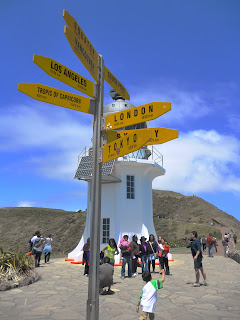"There is in the world, no greater host than an Australian" (Slavin, 2012).
I've currently been in Australia for two weeks and can say definitively that the above statement is a universal truth and it is one which gives me great pleasure to have learnt and share with you all.
I arrived in Sydney, Australia on the 19th December and met with my family Down Under - the proximity of kinship ties vastly closening when backpacking around the world - and was greeted with my first experience of Australian hospitality. It was wonderous and I thank each one of the Blumbergs for being so kind, generous and welcoming to 'that hairy pommy bloke' who turned up in Lindfield.
After several days of sightseeing Sydney; visiting the Opera House, Cockatoo Island, Bondi Beach, Manly, several museums, amongst a number of daytime and nightime visits to the city's many gems, I left Sydney's wettest and coldest winter in 60 years, took the train westwards and headed for rural Victoria to see how the Victorians were at this whole hospitality, letting-me-stay-for-free-and-giving-me-all-I-could-possibly-ask-for, thing.
Now if you ask anyone from Sydney what to expect of such folk, 'bogan', 'feral' and 'why on Earth are you going there' seem not to be uncommon replies. Yet I'll refute all such terms and say wholeheartedly that rural Victorians are the most hospitable people I've ever met. I arrived in Benalla, waiting to be picked up by the Collins of Coomboona and proceeded to spend the next 4 hours lying on a bench in the 35 degree heat (a cool day down these parts) talking with two very chatty locals. I might as well point out here, that chatting is one thing Australians are very good at. If you're the type of person who likes to sit and read, who likes a brief conversation of polite nicities followed by silence, I would advise you to not come to Australia. If however, you enjoy talking about everything and nothing, sharing anecdotes and witty asides, talking politics and football (that's AFL not soccer), I would recommend you went online, buy at ticket, start some oral exercises (again, no laughing at the back) and switch your brain on for many hours of insightful, varied and continued conversation.
In the eight days I've been in Victoria, I've spent two days on a houseboat in Echuca, provided with exquisite company, three-storied luxury accomodation, a rooftop hot tub with more beer than I could dream of consuming; multiple days in Bendigo where 'stay for a drink' inevitably seems to always turn into dinner, drinks, accomodation and a further invite to spend New Years Eve together; several lunches, dinners, drinks and day trips to Moama, Kyabrum, Shepparton, Mooroopna and of course, eight days in the superb hospitality of Sally Collins and the ever-generous Collin's household.
I simply can't exagerate when I talk of Australian hospitality, they very much are the reality of all that I've described and more. Sure, there will always be bad eggs, what with rural Australia known for quite a fair few brutal kidnappings and murders of backpackers - just watch Wolf Creek, actually a true story - but I have to say that I have been greeted with nothing but warmth, kindness and generosity. I'll most assuredly be sad to leave.
But travelling is, well just about that, travelling, and in two days time I'll pack my bags again, try and say a thank you worthy of the hospitality I've recieved, hit the road once more, paint my forehead with the label of 'backpacker' and head down to the parochial cafes, bars and beaches of Melbourne.
To everyone who has given me reason to make all the above conclusions, I sincerely thank you for every moment of generosity, every hour of conversation and every beer handed my way... It has all been immensly appreciated and I hope to return all that I've recieved when you find yourself my way.
Many thanks & to everyone a very Happy New Years








































